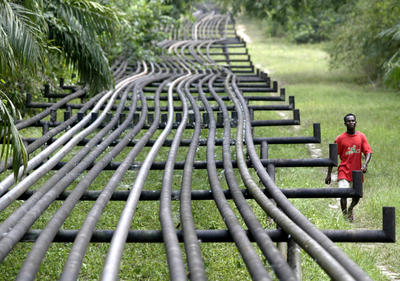Since 2000, China–Africa trade has grown at an average annual rate of 33.5 per cent. Although still second to the United States (whose trade with Africa amounted to US$140 billion in 2008), trade rose from US$55 billion in 2006 to around US$107 billion in 2008, accounting for 4.5 per cent of China’s total trade and surpassing the US$100 billion trade target set for 2010 at the 2006 Forum on China–Africa Cooperation (FOCAC). Trade is supported by modest yet rapidly expanding levels of direct investment, which reportedly jumped by 77 per cent in the first nine months of 2009, compared with the same period in 2008.
Most observers, says Harry Broadman, believe that Chinese (and to a lesser extent Indian) firms dominate Africa’s economies. This does not fit the facts. ‘About 90 per cent of the stock of FDI in Africa still originates from Europe and North America. FDI inflows from China have grown rapidly in recent years but the stock of capital from elsewhere is large. Nor are Chinese investors in Africa exclusively involved in natural resources’. Chinese and other investors from developing countries in Africa are increasing their investments in other sectors, such as telecommunications, financial services, food processing, manufacturing, infrastructure, back-office services and tourism. Natural resource-based investments dominate Chinese and Indian investors’ portfolios in Africa in value, Broadman points out, but the number of FDI projects by these MNEs is diversifying rapidly across many sectors.
As Deborah Brautigam points out in this week’s lead essay, Chinese development aid in Africa is also unusual in that much of the financial assistance provided does not constitute official development aid (ODA), but brings with it a focus on economic development opportunities. Much of it comes in the form of export credits and strategic lines of credit to Chinese-related companies, among other mechanisms. ‘In this sense’, she says, ‘it is very similar to Japanese financial flows to China several decades ago, when Japan began its outward march with a large line of credit to China, which, at the time, was not credit-worthy either. Looking at the nature of Chinese development aid — and non-aid — to Africa provides insights into China’s strategic approach to outward investment and economic diplomacy, even if exact figures and strategies are not easily ascertained’.
‘According to the Chinese white paper on aid released in April this year, approximately 40 per cent of China’s aid is financed through grants. Zero-interest loans are also a mainstay of China’s aid. The debt-relief program launched by Beijing in 2000 targeted overdue zero-interest loans for cancellation, with RMB25.58 billion worth (US$3.76 billion) cancelled, and of this, RMB18.96 billion (US$2.79 billion) was cancelled in Africa’.
‘Only large projects with a value of at least US$2.4 million, and that make a minimum 50 per cent use of Chinese goods and services, may be funded with concessional loans. China’s concessional loan program in Africa has grown rapidly. At the end of 2005, China Export–Import Bank had cumulatively funded only about US$800 million in concessionary loans in Africa, for 55 projects. Two years later, the number of African projects had risen to 87, and the cumulative value was about US$1.5 billion. And the government recently pledged US$10 billion in concessional/preferential credits for Africa, to be committed by 2012’.
The business-driven model of development that China now brings to Africa provides new opportunities to several African nations long overlooked — for being too high risk — as trading and investment partners. African countries and the African Union will need coherent, long-term strategies to apply leverage to international commercial interests and to create opportunities for enduring economic competitiveness and growth. But much is at stake for the 800 million people in sub-Saharan Africa, especially the 50 per cent of them who are among the world’s poorest, in the policy debate surrounding the continent’s accelerated integration into the world economy that is now prominently led by China and India.
Peter Drysdale is Editor of the East Asia Forum.

